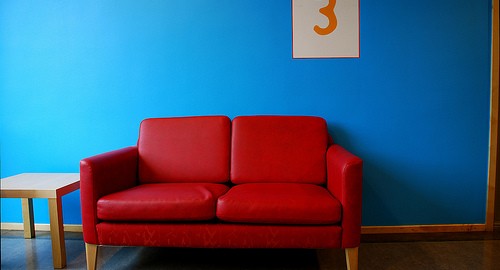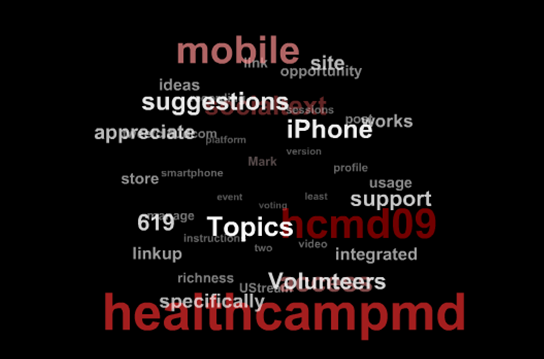8 Themes from the 2012 mHealth Summit
The mhealth field is growing by leaps and bounds, as evidenced by the more than 4,000 attendees from 50+ countries who navigated 4 tracks (technology, business, research, and policy) in three days at the 2012 mHealth Summit. Having attended all of the mHealth Summits since the first one back in 2009 (800 people, 2 days), it’s been great fun to see both the growth and the growing pains. Here are some of the themes that surfaced this year.
1. The waiting room
It’s often said that mhealth gives us the ability to deliver the right information to the right person in the right place at the right time. This year the waiting room was repeatedly recognized as a key place and time to deliver the right information to the right people. (Top photo, Waiting room by Astrid Westvang, courtesy of Flickr Creative Commons)
2. Swivel Apps
This wonderful term refers to apps that a doctor brings up on their screen and then swivels around to show their patient. Apps for anatomy and drug interactions are examples. The term was mentioned by Brian Dolan of MobiHealthNews (he wrote about it in his article, Epocrates for patients may be coming soon).
Swivel apps can foster better doctor-patient conversations and they provide patients with evidence-based resources. They represent a huge step forward in lowering a patient’s reliance on ‘Dr. Google.’ Health care providers will soon be prescribing apps to their patients, which will elevate the discussion of app certification (see Happtique’s draft app certification standards). This is a key area to watch.
3. Caregivers
“The Family Caregiver Tsunami: Innovation Needed – Fast!” The title of this talk by Mary Anne Sterling, CEO of Sterling Health IT Consulting, says it all. There’s need for coordinated care, caregiver support, and better access to information. The exhibit hall was full of services and devices that cater to this important aspect of health care.
4. Trackers
For gadget geeks, the exhibit hall was a cavernous candy store full of tasty treats. There were all sorts of trackers with varying degrees of usability, reliability, wearability and interoperability. This is going to be a very fun area to watch. (To help you track the trackers, here’s my wearable tech Pinterest board with 200+ health-centric gadgets).
(Shown, Sonny Vu of Misfit Wearables with the Shine and Thomas Blackadar of FitLinxx with the Pebble)
5. Nurses, wellness coaches, social workers
Numerous health care professionals – in addition to physicians – were mentioned as key stakeholders in the mhealth space. Michael Breslow, Chief Strategist of Phillips Healthcare, detailed an ecosystem of players engaged in both physical and virtual interactions.
In the article Technology will replace 80% of what doctors do, Vinod Khosla, a speaker at the meeting and founder of Khosla Ventures, states, “Diagnosis and treatment planning will be done by a computer, used in concert with empathetic support from medical personnel selected more for their caring personalities than for their diagnostic abilities.” (This article is a must-read).
6. Data
“The plural of anecdotes is not data.” – Francis Collins, Director, National Institutes of Health
We need to collect quality evidence for what works – or doesn’t – in mhealth interventions. The love-hate relationship between mhealth and randomized controlled trials (RCTs) continues to fester. While many complain that RCTs don’t fit in with the ‘fail fast’ iterative model of mhealth, other groups, such as HopeLabs, illustrate that well-designed RCTs can be deployed very successfully in this space. (For more on this, see Is the RCT too slow for mobile health?)
7. Adherence
“Technology tells us when someone is not adherent, but it doesn’t tell us why.” – Chanin Wendling, Manager, eHealth, Geisinger Health System. Adherence was repeatedly mentioned as a key issue, for example in keeping appointments and taking medications. There was more awareness of the importance of outcomes and behavior change rather than tools and technology. Hooray!
8. Partnerships
There were sessions on public-private partnerships and the exhibit hall was a partnership fiesta. Below is a video (showcased at the Summit) for Johnson & Johnson brand Band-Aids featuring the Muppets with mobile technology provided by Qualcomm. Yes, there’s an (augmented reality) app for that!
Other key themes included gaming, scaling, open mHealth, algorithms, and challenges – see the list below to learn more about these topics and others.
What others are saying about the 2012 mHealth Summit
- Games for Health pavilion: It’s not just fun and, well, you know, Eric Wicklund, mHIMSS
- Texting & health care delivery around the world #mHS12, Dr. Joseph Kim, MedicalSmartphones.com
- The Challenge to mHealth Scale-Up, Lily Wei, Center for Health Market Innovations
- The “Mobile” in “Mobile Health” Isn’t the Gadget, It’s the Data, RWJF
- mHealth is “so hot right now”… Ten themes from the 2012 mHealth Summit, Aaron Neinstein, Diabetes Technology
- What I Learned Day One at the mHealth Summit #mhs12, George Van Antwerp, Enabling Healthy Decisions
- From the mHealth Summit: The Medium or the Message?, Lois Parshley, UN Dispatch
Related posts
- The 2011 mHealth Summit Summed Up in 5 Quotes, Words and Companies, Plus 1 Jacket
- mHealth Summit 2010: A context check list
- The mHealth Summit: Local & Global Converge (2009 Summit and World Bank Day)
Videos of the opening remarks and keynote speakers from the mHealth Summit









[…] of all the presentations + interviews BNetTV interviews AIDS.Gov: Recapping the mHealth Summit Carol Torgan: 8 Themes from the mHealth Summit Diabetes Technology: Dr Aaron Neinstein: mHealth is “so hot right now”… HiStalkMobile: Travis […]
Cool blog. I will have to read up on your stuff and cite/link you on my blog.
“There was more awareness of the importance of outcomes and behavior change rather than tools and technology. Hooray!”
I couldn’t agree more with this sentiment. The role of behavioral psychology is incredibly important in tackling many of the issues we face in chronic disease… I am enjoying your blog…
Bobby and Bill, Thanks for your comments. While the mHealth space is growing at a fast rate, it’s still in it’s infancy. It will be very exciting to watch it mature, and I hope to see more psychologists, sociologists, and behavioral scientists at future Summits.
[…] 8 Themes from the 2012 mHealth Summit […]